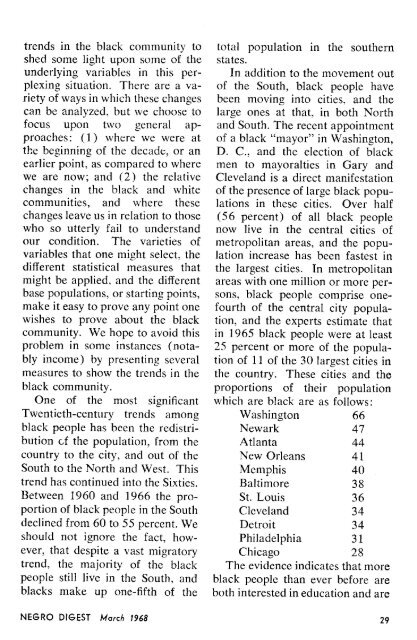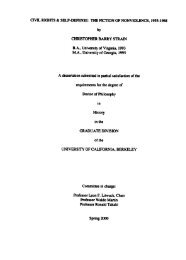Negro Digest - Freedom Archives
Negro Digest - Freedom Archives
Negro Digest - Freedom Archives
Create successful ePaper yourself
Turn your PDF publications into a flip-book with our unique Google optimized e-Paper software.
trends in the black community to<br />
shed some light upon some of the<br />
underlying variables in this perplexing<br />
situation . There are a variety<br />
of ways in which these changes<br />
can be analyzed, but we choose to<br />
focus upon two general approaches<br />
: (1) where we were at<br />
the beginning of the decade, or an<br />
earlier point, as compared to where<br />
we are now ; and ( 2 ) the relative<br />
changes in the black and white<br />
communities, and where these<br />
changes leave us in relation to those<br />
who so utterly fail to understand<br />
our condition . The varieties of<br />
variables that one might select, the<br />
different statistical measures that<br />
might be applied, and the different<br />
base populations, or starting points,<br />
make it easy to prove any point one<br />
wishes to prove about the black<br />
community . We hope to avoid this<br />
problem in some instances (notably<br />
income) by presenting several<br />
measures to show the trends in the<br />
black community .<br />
One of the most significant<br />
Twentieth-century trends among<br />
black people ha.s been the redistribution<br />
cf the population, from the<br />
country to the city, and out of the<br />
South to the North and West . This<br />
trend has continued into the Sixties .<br />
Between 1960 and 1966 the proportion<br />
of black people in the South<br />
declined from 60 to 55 percent . We<br />
should not ignore the fact, however,<br />
that despite a vast migratory<br />
trend, the majority of the black<br />
people still live in the South, and<br />
blacks make up one-fifth of the<br />
NEGRO DIGEST March 1968<br />
total population in the southern<br />
states .<br />
In addition to the movement out<br />
of the South, black people have<br />
been moving into cities, and the<br />
large ones at that, in both North<br />
and South . The recent appointment<br />
of a black "mayor" in Washington,<br />
D . C ., and the election of black<br />
men to mayoralties in Gary and<br />
Cleveland is a direct manifestation<br />
of the presence of large black populations<br />
in these cities . Over half<br />
(56 percent) of all black people<br />
now live in the central cities of<br />
metropolitan areas, and the population<br />
increase has been fastest in<br />
the largest cities . In metropolitan<br />
areas with one million or more persons,<br />
black people comprise onefourth<br />
of the central city population,<br />
and the experts estimate that<br />
in 1965 black people were at least<br />
25 percent or more of the population<br />
of 11 of the 30 largest cities in<br />
the country . These cities and the<br />
proportions of their population<br />
which are black are as follows :<br />
Washington 66<br />
Newark 47<br />
Atlanta 44<br />
New Orleans 41<br />
Memphis 40<br />
Baltimore 38<br />
St. Louis 36<br />
Cleveland 34<br />
Detroit 34<br />
Philadelphia 31<br />
Chicago 28<br />
The evidence indicates that more<br />
black people than ever before are<br />
both interested in education and are<br />
29
















